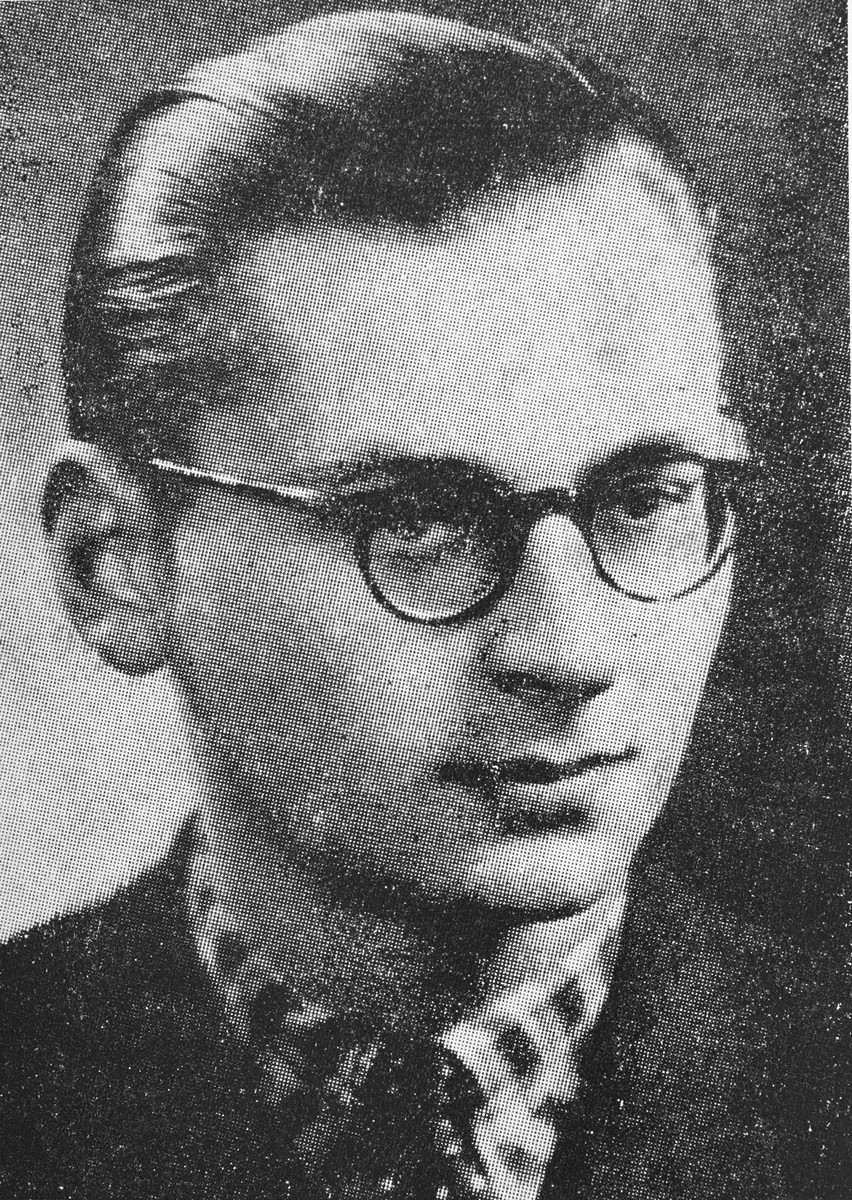Displaying: 476 – 500 of 1,022 matches for “Holocaust Encyclopedia: Warsaw”
-
476. Lucine Horn describes conditions in the Lublin ghetto
liquidated the ghetto. She eventually made her way to Warsaw where she first
-
477. Ludmilla Page describes arrival at the Brünnlitz munitions factory
ghetto; her mother was sent to the Warsaw ghetto. Ludmilla worked in a
-
478. Felix Horn describes postwar emigration with the Brihah movement and adjustment to life after the war
escaped and hid, eventually fleeing to the Warsaw ghetto, where Felix and ... Lucine were married. They escaped to the "Aryan" side of Warsaw and obtained false papers. Felix worked ... for the underground during the Warsaw Polish uprising in 1944. He and
-
479. Boleslaw Brodecki describes hangings in a labor camp and their impact on the prisoners
Warsaw. The Germans attacked Warsaw in September
-
480. Vladka (Fagele) Peltel Meed describes participating in activities of the Bundist underground
active in the Warsaw ghetto underground as a member of the Jewish Fighting ... Organization (ZOB). In December 1942, she was smuggled out to the Aryan, Polish side of Warsaw to try to obtain
-
481. Susan Bluman describes fleeing to Vilna after the occupation of Poland
eastern Poland. Nathan sent a guide to Warsaw to bring Susan to the Soviet ... zone of occupied Poland. Her parents reluctantly agreed after Susan promised to return to Warsaw within
-
482. Susan Bluman describes obtaining a transit visa from Chiune Sugihara
eastern Poland. Nathan sent a guide to Warsaw to bring Susan to the Soviet ... zone of occupied Poland. Her parents reluctantly agreed after Susan promised to return to Warsaw within
-
483. Irena Sendler describes how she was arrested and tortured by the Gestapo
(Sendlerowa) was working as a social worker in Warsaw when ... World War II broke out in 1939. After the Nazis forced Warsaw’s Jews to move into the ghetto in the ... Jewish children out of the Warsaw ghetto. She found hiding places for them in orphanages, convents
-
484. Rev. Marian Jacek Dabrowski
Marian in Warsaw. He was told that there was no real reason for his arrest, but that as an educated Pole
-
485. Isachar Herszenhorn (Irving Horn)
Warsaw. The city was the center of Poland's leather-tanning industry. Isachar's father worked as a
-
486. William (Bill) Lowenberg describes forced labor in the Kaufering subcamp of the Dachau concentration camp
Warsaw in late 1943, following the German suppression of the Warsaw ghetto
-
487. William (Bill) Lowenberg describes conditions in the Westerbork camp in the Netherlands
Warsaw in late 1943, following the German suppression of the Warsaw ghetto
-
488. William (Bill) Lowenberg describes Zionist and cultural activities in the Westerbork camp
Warsaw in late 1943, following the German suppression of the Warsaw ghetto
-
489. William (Bill) Lowenberg describes deportations from the Westerbork camp in the Netherlands
Warsaw in late 1943, following the German suppression of the Warsaw ghetto
-
490. Portrait of Żegota co-founder Władysław Bartoszewski

wave in Warsaw. The Nazi German authorities then sent him to the
-
491. Trucks used to transport Polish prisoners to the Palmiry forest for execution
wait with a convoy of trucks during a shooting action in the Palmiry forest near Warsaw. These trucks
-
492. Abraham Lewent describes the moments following his liberation from a death march from the Dachau camp
Like many other Jews, the Lewents were confined to the Warsaw
-
493. Ruth Berkowicz Segal describes journey to and arrival in Japan
Lithuania. Ruth left Warsaw with two friends to find her father and later ... soldiers from the front. Her mother, brother, and sisters perished in the Holocaust.
-
494. Ruth Berkowicz Segal describes finding her father in Vilna after he fled Soviet-occupied eastern Poland
Lithuania. Ruth left Warsaw with two friends to find her father and later ... soldiers from the front. Her mother, brother, and sisters perished in the Holocaust.
-
495. Lucine Horn describes her escape from the Majdan Tatarski ghetto
liquidated the ghetto. She eventually made her way to Warsaw where she first
-
496. Ludmilla Page recalls arriving in Auschwitz instead of Oskar Schindler's munitions factory in Brünnlitz
ghetto; her mother was sent to the Warsaw ghetto. Ludmilla worked in a
-
497. Ludmilla Page describes leaving Auschwitz and arriving at the Bruennlitz munitions factory in the Sudetenland
ghetto; her mother was sent to the Warsaw ghetto. Ludmilla worked in a
-
498. Ludmilla Page describes conditions in Oskar Schindler's munitions factory in Brünnlitz
ghetto; her mother was sent to the Warsaw ghetto. Ludmilla worked in a
-
499. Ludmilla Page describes sabotage during production of munitions in Oskar Schindler's factory in Brünnlitz
ghetto; her mother was sent to the Warsaw ghetto. Ludmilla worked in a
-
500. Ludmilla Page describes a celebration of Oskar Schindler's birthday in Bruennlitz toward the end of the war
ghetto; her mother was sent to the Warsaw ghetto. Ludmilla worked in a
